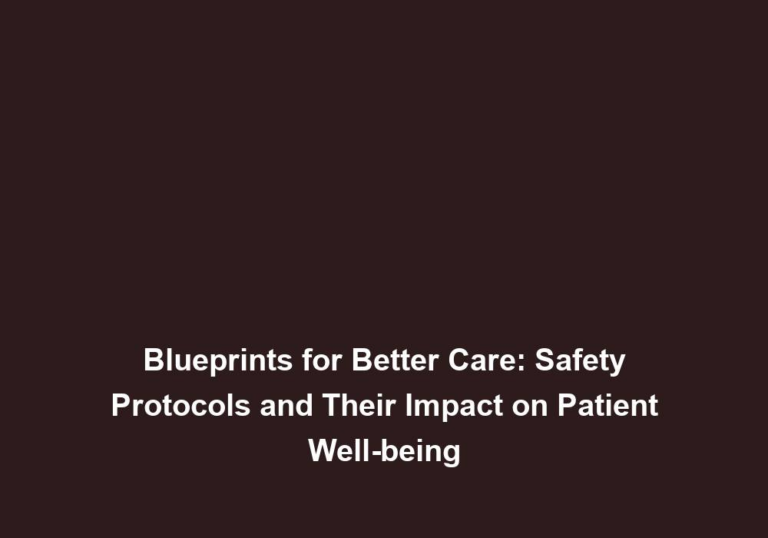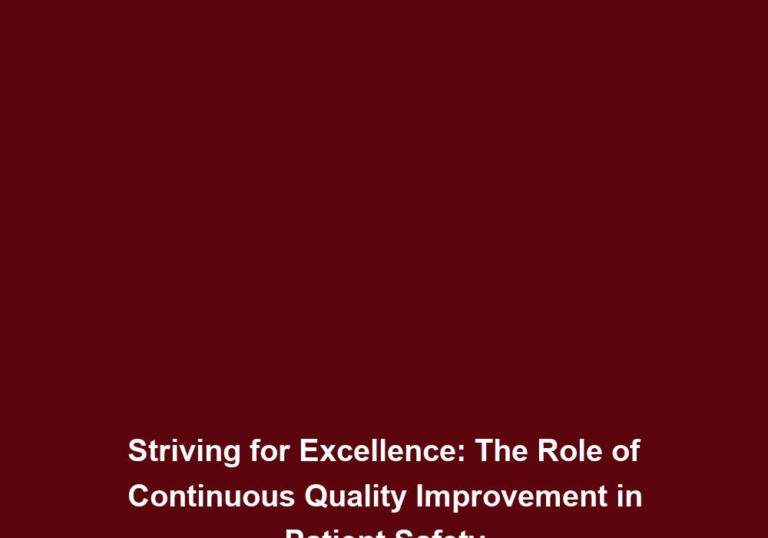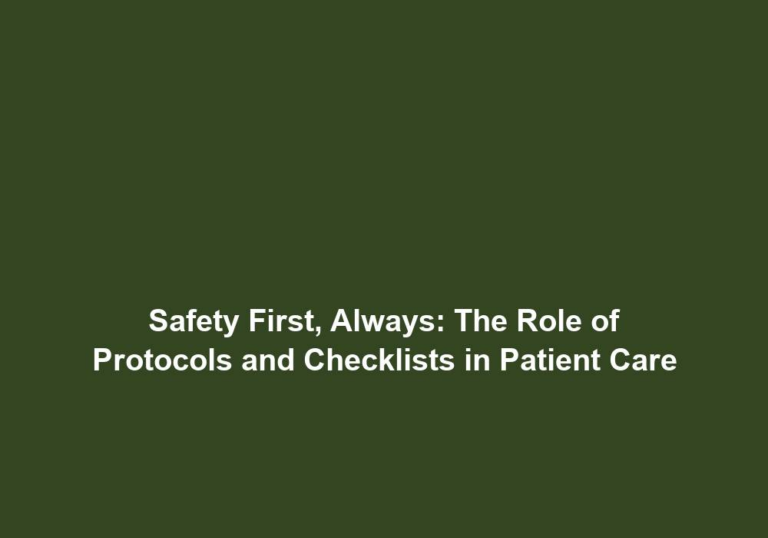Safety by Design: Implementing Robust Safety Protocols and Checklists
In today’s fast-paced world, where safety concerns are paramount in various industries, it is crucial to implement robust safety protocols and checklists. By adopting a proactive approach to safety and integrating it into the design process, businesses can mitigate risks, protect their workforce, and enhance overall operational efficiency. This article delves into the significance of safety by design, explores the benefits it offers, and provides actionable insights on implementing effective safety protocols and checklists.
Understanding Safety by Design
Safety by Design is a fundamental concept in engineering and industrial practices that focuses on integrating safety considerations throughout the design and development process. By prioritizing safety at the design stage, potential hazards and risks can be identified, addressed, and mitigated proactively. This approach ensures that safety measures are not an afterthought but rather an inherent part of the entire lifecycle of a product, system, or process.
Importance of Integrating Safety Considerations
Integrating safety considerations into the design process is crucial for several reasons:
-
Proactive Hazard Identification: By considering safety from the start, potential hazards can be identified early on. This allows businesses to address these hazards before they become a threat to the safety of employees, customers, or the general public.
-
Risk Mitigation: By integrating safety measures throughout the design process, businesses can mitigate risks and minimize the likelihood of accidents or incidents during operation. This not only protects the well-being of individuals but also prevents costly design changes or modifications later on.
-
Holistic Approach to Safety: Safety by design ensures that safety measures are not isolated or added as an afterthought. Instead, they are seamlessly integrated into the entire lifecycle of a product, system, or process. This holistic approach maximizes safety and minimizes the potential for errors or oversights.
Benefits of Implementing Safety by Design
Implementing safety by design offers a range of benefits for businesses:
-
Risk Reduction: Implementing safety protocols and checklists during the design phase helps identify and eliminate potential hazards, reducing the risk of accidents or incidents during operation. By addressing safety concerns early on, businesses can avoid costly design changes or modifications later.
-
Enhanced Productivity: Integrating safety into the design process enhances productivity by minimizing downtime due to accidents, injuries, or equipment failures. When safety is prioritized from the beginning, it becomes an integral part of the operational culture, leading to streamlined processes and increased efficiency.
-
Cost Savings: Incorporating safety measures during the design stage can lead to significant cost savings in the long run. By identifying and addressing potential safety hazards early on, businesses can avoid expensive rework, downtime, legal liabilities, and reputational damage associated with accidents or incidents.
-
Compliance and Regulatory Requirements: Implementing robust safety protocols and checklists ensures compliance with industry-specific regulations and standards. By adhering to these requirements, businesses can minimize legal risks, maintain a positive reputation, and gain a competitive edge in the market.
-
Employee Engagement and Satisfaction: Prioritizing safety by design demonstrates a commitment to the well-being of employees. When workers feel safe and protected, they are more engaged, motivated, and satisfied with their work environment, leading to higher productivity and lower turnover rates.
Implementing Effective Safety Protocols and Checklists
To implement robust safety protocols and checklists, businesses should consider the following steps:
Step 1: Identify Potential Hazards
Conduct a comprehensive risk assessment to identify potential hazards associated with the product, system, or process. This analysis should include identifying physical, chemical, ergonomic, and environmental hazards that could pose risks to employees, customers, or the general public.
- Create a checklist of potential hazards and assess their severity and likelihood of occurrence.
- Consider past incident reports, industry data, and expert input to ensure a comprehensive identification of hazards.
- Prioritize the most significant hazards that require immediate attention and mitigation measures.
Step 2: Design for Safety
Integrate safety features and mechanisms into the design to eliminate or minimize potential hazards. Consider ergonomic design principles, incorporate protective measures, and ensure clear warning signs or instructions are included where necessary. Collaborate with safety experts and stakeholders to gather valuable input during this stage.
- Incorporate fail-safe mechanisms, such as emergency shut-off switches or safety interlocks, to prevent accidents or equipment malfunctions.
- Utilize design principles that reduce ergonomic risks, such as proper workstation layouts, adjustable equipment, and ergonomic tools.
- Ensure clear and concise safety instructions and warnings are visible and easily understandable by all users.
Step 3: Develop Safety Protocols and Checklists
Create detailed safety protocols and checklists based on identified hazards and the specific requirements of the product, system, or process. These protocols should outline step-by-step procedures, safety guidelines, emergency response plans, and maintenance schedules to ensure ongoing safety and compliance.
- Clearly define roles and responsibilities for implementing safety protocols and checklists.
- Include detailed step-by-step procedures for routine tasks, maintenance activities, and emergency situations.
- Establish regular inspection and maintenance schedules to ensure equipment and systems remain in safe working condition.
Step 4: Communicate and Train
Effectively communicate safety protocols and checklists to all relevant stakeholders, including employees, contractors, and suppliers. Provide comprehensive training to ensure understanding and compliance with safety measures. Regularly reinforce safety messages through educational campaigns, toolbox talks, and ongoing training sessions.
- Conduct training sessions that cover the specifics of safety protocols, emergency procedures, and proper use of safety equipment.
- Use visual aids, such as posters and signage, to remind employees of key safety practices and procedures.
- Encourage open communication and feedback from employees regarding safety concerns or suggestions for improvement.
Step 5: Continuous Improvement
Regularly review and update safety protocols and checklists based on feedback, incident reports, and emerging best practices. Establish a culture of continuous improvement by encouraging employees to report safety concerns, near misses, and suggestions for enhancing safety measures.
- Conduct regular safety audits and inspections to identify potential gaps or areas for improvement.
- Analyze incident reports and near misses to identify trends or recurring issues that require additional attention.
- Stay updated with industry-specific regulations and standards to ensure ongoing compliance and implementation of best practices.
Conclusion
Implementing safety by design is crucial for organizations across various industries. By integrating safety protocols and checklists at the design stage, businesses can proactively identify and mitigate potential hazards, enhancing overall operational efficiency, reducing risks, and protecting their workforce. By following the steps outlined in this article, organizations can ensure the successful implementation of robust safety measures and foster a culture of safety throughout their operations. Remember, safety is not a choice; it is a responsibility that must be embraced by all.







